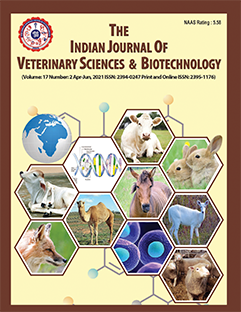Bilateral Ocular Affection Associated with Trypanosoma evansi Infection in German Shepherd Dog: A Case Report
DOI:
https://doi.org/10.48165/ijvsbt.21.4.40Keywords:
Trypanosomosis, arthropod, borne, infectious, diseaseAbstract
Trypanosomosis, an arthropod-borne infectious disease caused by a flagellate protozoan parasite, Trypanosoma evansi, poses significant economic challenges, particularly in the tropical regions such as India (Jaiswal et al., 2015). The disease affects bovines, canines, felines, and camelids. It is primarily transmitted mechanically by the biting haematophagous flies, with outbreaks becoming more frequent during the rainy season due to increased vector population (Jaiswal et al., 2015). Initially restricted to wild animals, over the time, disease has spread to the domestic animals (Sudan et al., 2017). Clinically, trypanosomosis presents with symptoms such as anorexia, emaciation, intermittent fever, progressive anaemia, conjunctivitis, limb edema, and superficial lymphadenopathy (Pandey et al., 2015). Neurological manifestations, like delirium, head pressing, ataxia, rear limb paralysis, and tonic-clonic seizures, have also been reported (Jaiswal et al., 2015; Sudan et al., 2017). Ocular involvement in canine trypanosomosis is rare, with limited literature available on the subject (Behera et al., 2017; Abbas et al., 2021). During disease development the parasites travel down from brain through optic nerve and causes deposition of immune complex in aquas humour which clinically results into development of corneal edema and opacity (Reddy and Sivajothi, 2017). This case report presents a clinical case of T. evansi induced ocular manifestations in a German Shepherd dog and its therapeutic management with diminazene aceturate in conjunction with supportive therapy.
Downloads
References
Abbas, H., Ullah, M.R., Rizwan, H.M., Farooqi, S.H., Ahmad, H.M., Ateeq, M.K., & Ahmad, M. (2021). Canine trypanosomosis: A case report. Journal of the Hellenic Veterinary Medical Society, 72(1), 2787–2790.
Baby, P.G., David, P.V., Kumar, S.A., & Jayakumar, C. (2000). A case of canine trypanosomosis with jaundice. Intas Polivet, 1, 106–107.
Behera, S.K., Sarma, K., Behera, P., & Ayub Ali, M. (2017). Therapeutic management of trypanosomosis with ophthalmic involvement in a dog. Journal of Parasitic Diseases, 41(4), 1162–1165.
Jaiswal, A.K., Sudan, B., Neha, & Verma, A.K. (2015). Insight into trypanosomiasis in animals: Various approaches for its diagnosis, treatment and control – A review. Asian Journal of Animal Science, 9, 172–186.
Pandey, V., Nigam, R., Jaiswal, A.K., Sudan, V., Singh, R.K., & Yadav, P.K. (2015). Haemato-biochemical and oxidative status of buffaloes naturally infected with Trypanosoma evansi. Veterinary Parasitology, 212(3–4), 118–122.
Panigrahi, P.N., Mahendran, K., Jena, S.C., Behera, P., Mahajan, S., Arjun, K., & Dey, S. (2015). Trypanosoma evansi infection in a German Shepherd dog – Apparent successful treatment using serial low dose of diminazene aceturate. Veterinary Parasitology: Regional Studies and Reports, 1, 70–74.
Reddy, S.B., & Sivajothi, S. (2017). Corneal opacity due to trypanosomosis in buffaloes – Need of topical medication. Open Access Journal of Science, 1(5), 00031.
Sarvanan, S., Basheer, A.M., Sundar, N., & Nedunchelliyan, S. (2005). Trypanosomosis in a German Shepherd dog. Indian Journal of Veterinary Medicine, 25, 62–62.
Sudan, V., Verma, A.K., & Jaiswal, A.K. (2017). Trypanosomosis of wild animals with emphasis on Indian scenario. Veterinary Parasitology: Regional Studies and Reports, 10, 25–28.
Varshney, J.P., Varshney, V.P., & Dwivedi, S.K. (1998). Clinico-endocrinological findings in clinical trypanosomiasis in dog. Journal of Veterinary Parasitology, 12, 143–144.
Downloads
Published
Issue
Section
License
Copyright (c) 2025 Indian Journal of Veterinary Sciences and Biotechnology

This work is licensed under a Creative Commons Attribution-NonCommercial-NoDerivatives 4.0 International License.




